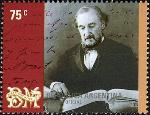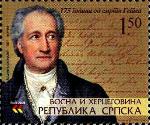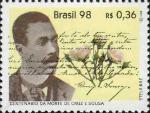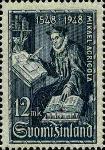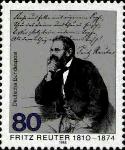| 10d--Manuscripts with Their Authors Please note that these examples are suggestive, not exhaustive of all possibilities. Please CLICK on an image for an ENLARGED version. |
Bartolomé Mitre Martinez (1821-1906) was an Argentine statesman, military figure, and
ranks as one of Argentina’s greatest writers. He was the president of Argentina from 1862 to
1868. When forced into exile, he worked as a soldier and journalist in Uruguay, Bolivia, Peru,
and Chile. Mitre founded La Nación, one of South America’s leading newspapers. He wrote the
best 19th-century accounts of South America's wars of independence and published many
works, amongst which are: Historia de Belgrano y de la Independencia Argentina [History of
Belgrano and of the Argentine Independence] (1857; fifth edition in four volumes, 1902); Historia
de San Martín y de la Emancipatión Sud-Americana [History of San Martín and the Emancipation of
South America] (1869; third edition in six volumes, 1907); Rimas [Rimes] (new edition, 1890);
Ulrich Schmidl, Primer Historiador del Rio de la Plata [Ulrich Schmidl, First Historian of the Rio de la
Plata] (1890). He also wrote poetry and fiction (Soledad: Novela Original). He translated Dante’s
La Divina Commedia (The Divine Comedy) into Spanish. To mark the centennial of his death,
Argentina issued a 75-centavo stamp showing Mitre the writer at work (Argentina, Scott #2368).
ranks as one of Argentina’s greatest writers. He was the president of Argentina from 1862 to
1868. When forced into exile, he worked as a soldier and journalist in Uruguay, Bolivia, Peru,
and Chile. Mitre founded La Nación, one of South America’s leading newspapers. He wrote the
best 19th-century accounts of South America's wars of independence and published many
works, amongst which are: Historia de Belgrano y de la Independencia Argentina [History of
Belgrano and of the Argentine Independence] (1857; fifth edition in four volumes, 1902); Historia
de San Martín y de la Emancipatión Sud-Americana [History of San Martín and the Emancipation of
South America] (1869; third edition in six volumes, 1907); Rimas [Rimes] (new edition, 1890);
Ulrich Schmidl, Primer Historiador del Rio de la Plata [Ulrich Schmidl, First Historian of the Rio de la
Plata] (1890). He also wrote poetry and fiction (Soledad: Novela Original). He translated Dante’s
La Divina Commedia (The Divine Comedy) into Spanish. To mark the centennial of his death,
Argentina issued a 75-centavo stamp showing Mitre the writer at work (Argentina, Scott #2368).
Johann Wolfgang von Goethe (1749-1832) was a German poet, novelist, playwright,
statesman, and scientist. In 1773 he provided the Sturm und Drang Movement with its first
major drama, Götz von Berlichingen, and in 1774 with its first novel, The Sorrows of Young
Werther, an extraordinarily popular work in its time, in which he created the prototype of the
Romantic hero. In 1775 he arrived at Weimar, where he accepted an appointment to the ducal
court; he would remain there for the rest of his life, and his presence helped to establish
Weimar as a literary and intellectual center. His poetry includes lyrics in praise of natural
beauty and ballads that echo folk themes. His contact with ancient Classical culture during an
Italian sojourn (1786–88) deeply influenced his later work. After 1794, Friedrich Schiller became
his most important and influential friend. Wilhelm Meister’s Apprenticeship (1795–96) is often
called the first bildungsroman, or coming-of-age novel; it was followed many years later by The
Wanderings of Wilhelm Meister (1821; 2nd ed. 1829). Many of Goethe’s works were inspired by a
series of passionate loves for women. His chief masterpiece, the drama Faust (Part One, 1808;
Part Two, 1832), represents Faust tragically, as a singularly modern figure who is condemned to
remain unsatisfied by life. Goethe also wrote extensively on botany, color theory, and other
scientific topics. In his late years he was celebrated as a sage and visited by world luminaries.
The greatest figure of German Romanticism, he is regarded as a giant of world literature. The
image of Goethe on this stamp, which is superimposed over a page of his writings, is based
upon an 1828 oil portrait by Joseph Karl Stieler (Bosnia & Herzegovina—Serbian Authority,
Scott #289).
statesman, and scientist. In 1773 he provided the Sturm und Drang Movement with its first
major drama, Götz von Berlichingen, and in 1774 with its first novel, The Sorrows of Young
Werther, an extraordinarily popular work in its time, in which he created the prototype of the
Romantic hero. In 1775 he arrived at Weimar, where he accepted an appointment to the ducal
court; he would remain there for the rest of his life, and his presence helped to establish
Weimar as a literary and intellectual center. His poetry includes lyrics in praise of natural
beauty and ballads that echo folk themes. His contact with ancient Classical culture during an
Italian sojourn (1786–88) deeply influenced his later work. After 1794, Friedrich Schiller became
his most important and influential friend. Wilhelm Meister’s Apprenticeship (1795–96) is often
called the first bildungsroman, or coming-of-age novel; it was followed many years later by The
Wanderings of Wilhelm Meister (1821; 2nd ed. 1829). Many of Goethe’s works were inspired by a
series of passionate loves for women. His chief masterpiece, the drama Faust (Part One, 1808;
Part Two, 1832), represents Faust tragically, as a singularly modern figure who is condemned to
remain unsatisfied by life. Goethe also wrote extensively on botany, color theory, and other
scientific topics. In his late years he was celebrated as a sage and visited by world luminaries.
The greatest figure of German Romanticism, he is regarded as a giant of world literature. The
image of Goethe on this stamp, which is superimposed over a page of his writings, is based
upon an 1828 oil portrait by Joseph Karl Stieler (Bosnia & Herzegovina—Serbian Authority,
Scott #289).
João da Cruz e Sousa (1861–1898), a symbolist poet from Santa Catarina, Brazil, was the son
of freed slaves. He traveled widely throughout Brazil in early adulthood, both as a member of a
theatrical company and in abolitionist campaigns. His first poems were published in 1877, but
his career gained momentum shortly after 1890, when he came in contact with the literary circle
of Rio de Janeiro. Called the Cisne Negro (“Black Swan”) by his contemporaries, he was the chief
poet and luminary of the Symbolist Movement throughout his relatively short life. His poetry
weds the technical principles of French Symbolism to themes drawn from his social concerns
and his own personal suffering. One of the great Afro-Brazilian writers, he was widely admired
and emulated by younger poets of his own country, as well as those involved in the Modernist
movement in Latin America. His three best-known collections of poetry were published in the
1890s: Broquéis (Shields) in 1893, Missal, a volume of poetic prose (1893), and Faróis (Beacons),
published posthumously in 1900. He died of tuberculosis in 1898. This stamp commemorates
the 100th anniversary of his death and features Cruz e Sousa’s portrait superimposed on a
piece of his writing (Brazil, Scott #2669).
of freed slaves. He traveled widely throughout Brazil in early adulthood, both as a member of a
theatrical company and in abolitionist campaigns. His first poems were published in 1877, but
his career gained momentum shortly after 1890, when he came in contact with the literary circle
of Rio de Janeiro. Called the Cisne Negro (“Black Swan”) by his contemporaries, he was the chief
poet and luminary of the Symbolist Movement throughout his relatively short life. His poetry
weds the technical principles of French Symbolism to themes drawn from his social concerns
and his own personal suffering. One of the great Afro-Brazilian writers, he was widely admired
and emulated by younger poets of his own country, as well as those involved in the Modernist
movement in Latin America. His three best-known collections of poetry were published in the
1890s: Broquéis (Shields) in 1893, Missal, a volume of poetic prose (1893), and Faróis (Beacons),
published posthumously in 1900. He died of tuberculosis in 1898. This stamp commemorates
the 100th anniversary of his death and features Cruz e Sousa’s portrait superimposed on a
piece of his writing (Brazil, Scott #2669).
Finland commemorated the 400th anniversary of the publication the Finnish translation of the New
Testament by Michael Agricola (ca.1510-1557) with this stamp. It depicts Agricola, a Finnish
clergyman, who became de facto father of the Finnish written language and one of the prominent
proponents of the Protestant Reformation in Sweden-Finland, working on his translation. Agricola
was consecrated as the bishop of Turku in 1554 without papal approval. As a result, he began a
reform of the Finnish church along Lutheran lines. He translated the New Testament, the
prayerbook, hymns, and the mass into Finnish. Through this work he set the rules of orthography
that are the basis of modern Finnish spelling. His thoroughgoing work is particularly remarkable in
that he accomplished it in only three years. He died suddenly on a return trip from negotiating a
treaty with the Russians. The stamp’s image is based upon an engraving of Agricola by Albert
Edelfelt (1854–1905) (Finland, Scott #277).
Testament by Michael Agricola (ca.1510-1557) with this stamp. It depicts Agricola, a Finnish
clergyman, who became de facto father of the Finnish written language and one of the prominent
proponents of the Protestant Reformation in Sweden-Finland, working on his translation. Agricola
was consecrated as the bishop of Turku in 1554 without papal approval. As a result, he began a
reform of the Finnish church along Lutheran lines. He translated the New Testament, the
prayerbook, hymns, and the mass into Finnish. Through this work he set the rules of orthography
that are the basis of modern Finnish spelling. His thoroughgoing work is particularly remarkable in
that he accomplished it in only three years. He died suddenly on a return trip from negotiating a
treaty with the Russians. The stamp’s image is based upon an engraving of Agricola by Albert
Edelfelt (1854–1905) (Finland, Scott #277).
Emilian Stanev is the pseudonym of Nikola Stoyanov Stanev (1907–1979), a 20th- century Bulgarian prose writer and
master of the short story. Stanev was born in Tarnovo in 1907 and spent his childhood in Tarnovo and Elena, where he
long lived with his family. From an early age, his father would take him to his hunting outings in the open, which had an
impact on Stanev's later work, where nature is often described. Stanev published his first works in 1931. He was active in
a number of magazines and newspapers: he headed the fiction department of the Literary Front newspaper and wrote tales
involving animals, social and philosophical prose, historical novels and novelettes that were widely published. Stanev's
first book was a collection of short stories named Tempting Glitters issued in 1938. His next book was the collection Alone
from 1940, and the books to follow were Wolfish Nights (1943), Workdays and Holidays (1945), Wild Bird (1946), and In a
Silent Night (1948). One of his best-known works, The Peach Thief, was published in 1948 and filmed in 1964 with Bulgarian
actress Nevena Kokanova starring as Elisaveta. After 1950, he worked for 14 years on his novel Ivan Kondarev describing
the events surrounding the September Uprising of 1923. Stanev also wrote many books for children and teenagers. His
later works had more philosophical themes in which he employed his in-depth knowledge of the history of Bulgaria. The
novels Legend of Sibin, the Prince of Preslav (1968), Tihik and Naziriy, Antichrist (1970), The Queen of Tarnovo (1974), all date to
this period. Stanev died in Sofia in 1979. This stamp, which has an attached label, was issued on 28 February 2007. Both
depict Stanev with handwritten and typewritten manuscripts as background elements (Bulgaria, Scott #4421).
master of the short story. Stanev was born in Tarnovo in 1907 and spent his childhood in Tarnovo and Elena, where he
long lived with his family. From an early age, his father would take him to his hunting outings in the open, which had an
impact on Stanev's later work, where nature is often described. Stanev published his first works in 1931. He was active in
a number of magazines and newspapers: he headed the fiction department of the Literary Front newspaper and wrote tales
involving animals, social and philosophical prose, historical novels and novelettes that were widely published. Stanev's
first book was a collection of short stories named Tempting Glitters issued in 1938. His next book was the collection Alone
from 1940, and the books to follow were Wolfish Nights (1943), Workdays and Holidays (1945), Wild Bird (1946), and In a
Silent Night (1948). One of his best-known works, The Peach Thief, was published in 1948 and filmed in 1964 with Bulgarian
actress Nevena Kokanova starring as Elisaveta. After 1950, he worked for 14 years on his novel Ivan Kondarev describing
the events surrounding the September Uprising of 1923. Stanev also wrote many books for children and teenagers. His
later works had more philosophical themes in which he employed his in-depth knowledge of the history of Bulgaria. The
novels Legend of Sibin, the Prince of Preslav (1968), Tihik and Naziriy, Antichrist (1970), The Queen of Tarnovo (1974), all date to
this period. Stanev died in Sofia in 1979. This stamp, which has an attached label, was issued on 28 February 2007. Both
depict Stanev with handwritten and typewritten manuscripts as background elements (Bulgaria, Scott #4421).
The Deutsches Wörterbuch (called DWB or “der Grimm”) is an etymological dictionary of the
German language started by the brothers Grimm, Wilhelm Grimm (1786-1859) and Jacob
Grimm (1785-1863), in 1838. This German Dictionary contains detailed information about the
origin and usage examples of German words, both historically and (at the time of writing)
modern. When the project was finally finished in 1961, the dictionary contained 32 volumes and
included about 350,000 main entries. In 1971 a supplement with references was published.
Germany issued this stamp on 10 January 1985, and it depicts both brothers with a manuscript
background of a page from Deutsches Wörterbuch (Germany, Scott 1434).
German language started by the brothers Grimm, Wilhelm Grimm (1786-1859) and Jacob
Grimm (1785-1863), in 1838. This German Dictionary contains detailed information about the
origin and usage examples of German words, both historically and (at the time of writing)
modern. When the project was finally finished in 1961, the dictionary contained 32 volumes and
included about 350,000 main entries. In 1971 a supplement with references was published.
Germany issued this stamp on 10 January 1985, and it depicts both brothers with a manuscript
background of a page from Deutsches Wörterbuch (Germany, Scott 1434).
Dialect author, Fritz Reuter (1810-1874), was a German novelist who helped to initiate the
development of regional dialect literature in Germany. His best works, which mirrored the
provincial life of Mecklenburg, are written in Plattdeutsch, a north German dialect. The success
of his early Plattdeutsch poems and stories led him to attempt more ambitious works in his
native dialect. Ut de Franzosentid (1859; During the Time of the French Conquest) presents, with a
mixture of seriousness and humor, life in a Mecklenburg country town during the War of
Liberation against Napoleon. Ut mine Festungstid (1862; During the Time of My Incarceration) is an
account of his last few years in prison told without bitterness. Ut mine Stromtid (1862–64; During
My Apprenticeship) is considered his masterpiece. In this work, originally issued in three
volumes, Reuter’s resemblance to Charles Dickens as a great storyteller and as a creator of
characters is most apparent; its humorous hero, Entspektor Bräsig, is as memorable as Mr.
Pickwick. This stamp, issued by Germany on 15 October 1985 shows Reuter seated with a page
of a manuscript as background (Germany, Scott #1449).
development of regional dialect literature in Germany. His best works, which mirrored the
provincial life of Mecklenburg, are written in Plattdeutsch, a north German dialect. The success
of his early Plattdeutsch poems and stories led him to attempt more ambitious works in his
native dialect. Ut de Franzosentid (1859; During the Time of the French Conquest) presents, with a
mixture of seriousness and humor, life in a Mecklenburg country town during the War of
Liberation against Napoleon. Ut mine Festungstid (1862; During the Time of My Incarceration) is an
account of his last few years in prison told without bitterness. Ut mine Stromtid (1862–64; During
My Apprenticeship) is considered his masterpiece. In this work, originally issued in three
volumes, Reuter’s resemblance to Charles Dickens as a great storyteller and as a creator of
characters is most apparent; its humorous hero, Entspektor Bräsig, is as memorable as Mr.
Pickwick. This stamp, issued by Germany on 15 October 1985 shows Reuter seated with a page
of a manuscript as background (Germany, Scott #1449).
Eduard Friedrich Mörike (1804-1875), one of Germany’s greatest lyric poets, studied
theology at Tübingen and held several curacies before 1834, when he become pastor of
Cleversulzbach, the remote Württemberg village immortalized in Der Alte Turmhahn, where
inhabitants and pastor are seen through the whimsical but percipient eyes of an old
weathercock. All his life Mörike suffered from psychosomatic illnesses, which were possibly
intensified by an unconscious conflict between his humanist aspirations and his church
dogmas. His novel, Maler Nolten (1832), explores the realm of the subconscious and the
mysterious forces linking the main character and his early love even beyond the grave. Mörike’
s poems in folk-song style and his fairy tales also show the influence of German romanticism.
Das Stuttgarter Hutzelmännlein (1853), is his best folk tale, and Mozart auf der Reise nach Prag
(1856), he penetrates deeper into Wolfgang Amadeus Mozart’s personality than do many longer
studies. It is, however, as a lyric poet that Mörike was at the height of his powers. Mörike
worked with free rhythms, sonnets, regular stanza forms, and, more particularly in his later
poems, classical meters with equal virtuosity. The “Peregrina” poems, immortalizing a youthful
love of his Tübingen days, and the sonnets to Luise Rau, his one-time betrothed, are among
the most exquisite German love lyrics. This stamp issued by Germany on 9 September 2004,
commemorating the bicentennial of his birth, show manuscript pages of work by Mörike
overlain by a quill pen, ink well, and a pair of glasses (Germany, Scott #2296).
theology at Tübingen and held several curacies before 1834, when he become pastor of
Cleversulzbach, the remote Württemberg village immortalized in Der Alte Turmhahn, where
inhabitants and pastor are seen through the whimsical but percipient eyes of an old
weathercock. All his life Mörike suffered from psychosomatic illnesses, which were possibly
intensified by an unconscious conflict between his humanist aspirations and his church
dogmas. His novel, Maler Nolten (1832), explores the realm of the subconscious and the
mysterious forces linking the main character and his early love even beyond the grave. Mörike’
s poems in folk-song style and his fairy tales also show the influence of German romanticism.
Das Stuttgarter Hutzelmännlein (1853), is his best folk tale, and Mozart auf der Reise nach Prag
(1856), he penetrates deeper into Wolfgang Amadeus Mozart’s personality than do many longer
studies. It is, however, as a lyric poet that Mörike was at the height of his powers. Mörike
worked with free rhythms, sonnets, regular stanza forms, and, more particularly in his later
poems, classical meters with equal virtuosity. The “Peregrina” poems, immortalizing a youthful
love of his Tübingen days, and the sonnets to Luise Rau, his one-time betrothed, are among
the most exquisite German love lyrics. This stamp issued by Germany on 9 September 2004,
commemorating the bicentennial of his birth, show manuscript pages of work by Mörike
overlain by a quill pen, ink well, and a pair of glasses (Germany, Scott #2296).
| Last Updated on 31 August 2009 |
